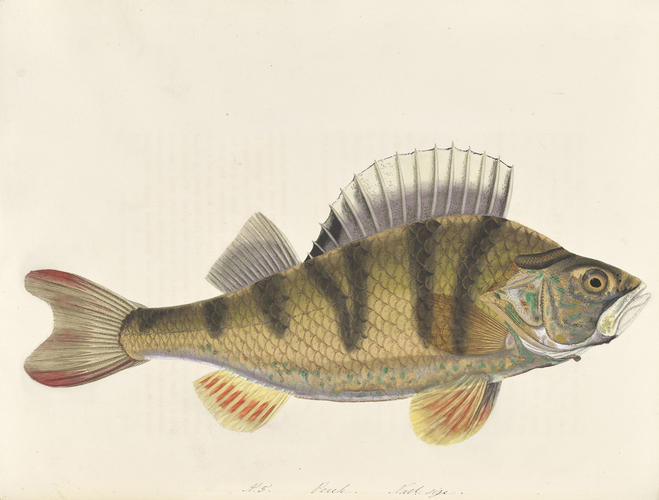The Fresh-water fishes of Great Britain 1828
RCIN 1057038
-
Sarah Bowdich’s Fresh-Water Fishes of Great Britain is an incredibly rare work on ichthyology and an important source for the significant, yet often hidden, roles of women naturalists in the early nineteenth century.
As a result of an 18-month expedition to the Gold Coast (now Ghana) and Gabon between 1816 and 1818, Sarah Bowdich became the first European woman to collect plant specimens in tropical West Africa and the first to discover entirely new genera of plants. Bowdich had accompanied her husband, Thomas, to Africa after he had been selected to participate in the African Company of Merchants expedition to Kumasi, the capital of the Asante Empire (see his account of the mission, RCIN 1141466). After their return to England, the couple travelled to Paris where they made the acquaintance of Georges Cuvier and Alexander von Humboldt, two of the preeminent European naturalists of the age.
In 1822, the Bowdichs once again left Europe for Africa but in January 1824, Thomas fell ill and died in Gambia, leaving his wife and children stranded. Once she had managed to secure passage home, Bowdich embarked on a literary career to support her children. After being approached by the entrepreneurial publisher Rudolph Ackermann and with the support of Cuvier and her other friends in the natural history community, she set about producing a survey of British freshwater fishes. Rather than being a catalogue of all the species of fish found in British ponds, lakes, rivers and streams, Bowdich selected 47 commonly caught fish and devised her book as a field guide, providing physical descriptions and useful information about where they could be found.
Only fifty complete copies of Fresh-Water Fishes are known, each with watercolours made by Bowdich herself 'from the living fish immediately [after] it came from the water it inhabited'. To do this, she left her home in London and travelled to Essex, Sussex, Gloucestershire, Derbyshire and Scotland, catching, recording and painting fish. Where she could not visit in person, she arranged for friends to send her living specimens, providing them with intricate details about how to keep the fish alive on the long journey to London.
Issued in twelve fascicules containing four watercolours each, Bowdich painted every fish repeatedly, producing a total of 2,200 paintings between 1827 and 1837. Pinholes where the paper was attached to a board are still visible in each plate in the Royal Library’s copy. The decision not to arrange for lithographs or other printed plates to be made from her pictures meant that Bowdich had full control over the scale and colouring of each image. Bowdich’s paintings are incredibly lifelike and highly accurate, with the sheen of the scales and the translucency of the fins of each fish being effectively reproduced through the layering of transparent and opaque washes.
In this work, Bowdich was the first naturalist to make use of Cuvier’s then unpublished new classification of fish. In addition, her descriptions, unlike many of her male contemporaries, were accessible to general readers and helped to unveil the wonders of aquatic life. Bowdich would go on to write a memoir of Cuvier (1833) and several natural history textbooks that would remain standard schoolbooks for much of the nineteenth century.
-
Creator(s)
(publisher) -
Alternative title(s)
The Fresh-water fishes of Great Britain / by Mrs T. Edward Bowditch.









